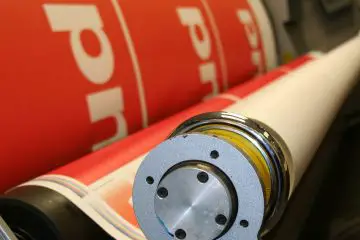The digital advertising market is booming. Thanks to social media, SEO, and other digital marketing strategies, advertising expenditure in the digital sector is constantly increasing.
No wonder: our living environment is increasingly taking place online, so it is only logical that advertising follows its target group. Nevertheless, the brave, Gallic village sticks to the credo: Print is not dead. But do printed matter and offline marketing really still have a future?
What does print marketing include?
Basically, the term print marketing, also known as print advertising, includes all marketing measures that are printed on paper. Specifically, this includes the following printed matter:
- Flyers
- Posters
- Catalogs
- Brochures
- Magazines
- Advertisements in trade journals & newspapers
Why has online marketing overtaken printed matter?
The Development of a digital advertising market is only logical. Because advertising is always based on the behavior of the target group. Due to social developments, this is much more active on the Internet. Smartphones and social media have of course made a major contribution to this.
After all, smartphones are constantly in use and social media enable networking and permanent contact with other people. Accordingly, it is important for companies to also take place in this context.
In addition, online marketing is easier to control, play out and measure. An advertisement on Google (SEA) can be precisely tailored to search terms and target groups. During the campaign, data can be read out in real-time and the advertisement can be optimized in terms of clicks and conversions. This is not possible with a flyer or a poster.
Last but not least: the design options are greater. Finally, creatives can draw on the full potential of online ads and combine video with sound to create an appealing overall experience.
Is print marketing really dead?
Don’t worry, the answer is clear: Print is not dead. Not yet. Of course, there are fewer print products overall, and the magazine and newspaper market in particular is becoming thinner and thinner. Nevertheless, print products will continue to exist in the near future and will play an important role in the marketing mix.
This finding is supported by various surveys. Statistics from Statista from 201 show that online marketing is ahead with 35.9% advertising. However, print marketing follows closely behind with 33.5%. There is also postal advertising, which also accounts for a larger share.
This advertising expenditure for print marketing also fits the usage behavior that the study analyzed and presented. According to this, 70-88% read magazines – and these are distributed across all age groups with the lowest proportion between 14-19 years (75%) and the highest proportion among those over 60 years of age (93%).
Good reasons to focus on print advertising
The print market is far from dead. And there are various reasons for that. There are simply still target groups that have an affinity for print and are difficult to reach online. Of course, these are often older people, but depending on the product, they can make up the core of your customers.
But it’s not just older people who read magazines. Accordingly, there is still a large number of people who like to pick up printed items.
There are many reasons for this. Apparently, haptics plays a role. Ideally, print marketing always resonates with a certain value that is difficult to achieve in the digital sector. It’s about the feeling, the scent, and also the color brilliance provided it is a high-quality printed product.
People who put a magazine or brochure in their hand usually take more time for it. While online marketing is fast-moving, print has more time. There is also a certain exclusivity that resonates with a high-quality print product.
It also plays a major role that trust in the reliability of print marketing and Printed matter is significantly higher. According to a study, 63% of people trust editorial media, while only 29% put their trust in social media.
In short: print marketing convinces with value, exclusivity, and trustworthiness, and suits certain target groups. It doesn’t really need more reasons to say clearly: Print is not dead! But how does good print marketing work today?
5 tips for better print marketing
1. Look ahead, not back
Many marketers only deal with print marketing to wistfully wish back to the past times. Was the print market more productive in the past? Of course, after all, there were fewer alternatives. But the market has always changed and adapted to new situations.
Even the widespread introduction of radio or television has influenced the possibilities of printed matter. Any change in the media sector requires reflection and adjustment. Accordingly, it should not be mourned as it once was. Instead, you are looking for ways to position your company in the best possible way in the current situation and with a view to the future.
2. Think cross-channel
If you set up a new campaign or communication strategy, then plan all channels. Don’t think of print separately from social media or SEO. Bring all aspects together in a cross-channel campaign.
Of course, you pay attention to the respective specifics of the media and adapt your idea as best as possible. This allows you to set up a campaign that works holistically and promises success.
3. Create bridges between offline and online
Offline and online can complement each other. A classic example of this is QR codes. Interested parties can scan these to be guided from the print medium to the digital.
Your flyer or brochure then forms a contact point that you underpin with digital content. Just like Google Ads lead to a landing page, print ads and printed matter can also work.
So bring offline and online together and offer your customers the best possible overall impression.
4. Rely on virality through creativity
That only works in online marketing, right?! Wrong thought! Because even creative poster ads and advertising materials can go viral. After all, they are quickly photographed with the smartphone and shared across all channels.
The basic requirement for this: is creativity and quality. Your print marketing must generate emotions, be visually appealing and really appeal to your target group overall. This is how you manage that your customers willingly give you more reach than you would ever have expected in print marketing.
5. Consider the Customer Journey
Print and online advertising can easily coexist and push each other. Ideally, they address your customers as a contact point at different steps within the customer journey. While the flyer or brochure may be the first point of contact with your product, your social media presence is already one step further.
Whether search engine ads, social media Advertising, web banners, posters, flyers, or print ads: all of these ads mark different points with their own relevance for certain parts of your target group. Each of these points marks a separate point within the customer journey.
Ideally, you should not think of print and offline separately, but as a big whole that offers customers the best possible Away from attention to interest to desire and action.

![Print is not Dead - Benefits of Print Advertising [Complete Guide]](https://www.ephatech.com/wp-content/uploads/2022/11/pexels-kaboompics-com-6224.jpg)





